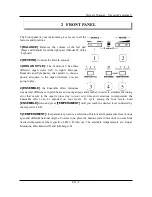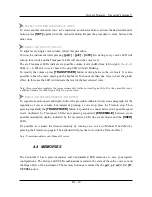
Owner's Manual – Viscount Cantorum V
➢
SAVE A USER MEMORY
To
save a user memory push
[SET]
together with a memory button (buttons
[
pp
/1]
to
[TUTTI/6]
).
➢
RECALL A MEMORY
To recall a memory push the relative button (buttons
[
pp
/1]
to
[TUTTI/6]
). Push the
[USER]
button to switch from factory memories to USER memories and viceversa.
To recall a memory placed in the other bank always remember to press
[USER]
and then the
desired memory button.
Note: please remember that memories also save the current Organ Style.
When a memory is active it is possible to turn off all the registers at the same time (this function is
normally called Cancel), by pressing the active memory button. In this state the organ will still send
MIDI messages, allowing the use of the Cantorum V as a “mute keyboard” (or Master Keyboard),
that is capable of driving another keyboard, organ, sequencer, without generating sounds. For
example it can be useful to connect it to another Viscount organ or expander (as CM100) to let its
voices sound.
To let the Cantorum V sound again just activate registers or memories.
When no memory is employed (all memory LEDs are Off) the Cantorum V is in the “HR mode”. If
any memory is active it is sufficient to press it again to deactivate it and enter the HR mode. Under
this mode, the state of the registers is always retained.
4.5 MIDI
MIDI BASICS
The MIDI (Musical Instrument Digital Interface) interface allows instruments of different makes and kinds to
communicate with each other, using this very specific protocol of codes. This allows the creation of systems of MIDI
instruments, offering much greater versatility and control than is possible with single instruments. To make this
communication possible, all MIDI instruments have two or three 5-pin DIN connectors called:
-
MIDI IN:
The connector through which the instrument receives the MIDI data transmitted by other units.
-
MIDI OUT:
The connector through which the instrument sends the MIDI data it has generated to other units.
Most instruments equipped with MIDI interface transmit MIDI messages which specify, for example, which note has
been played and with what dynamic, by means of the MIDI OUT connector. If this connector is connected to the MIDI
IN connector of another MIDI instrument, such as an expander, the second instrument will respond exactly to the notes
played on the transmitter instrument. The same type of information transfer is used for recording MIDI sequences. A
computer or a sequencer can be used to record the MIDI data generated by the transmitter instrument. If the recorded
EN - 11














































